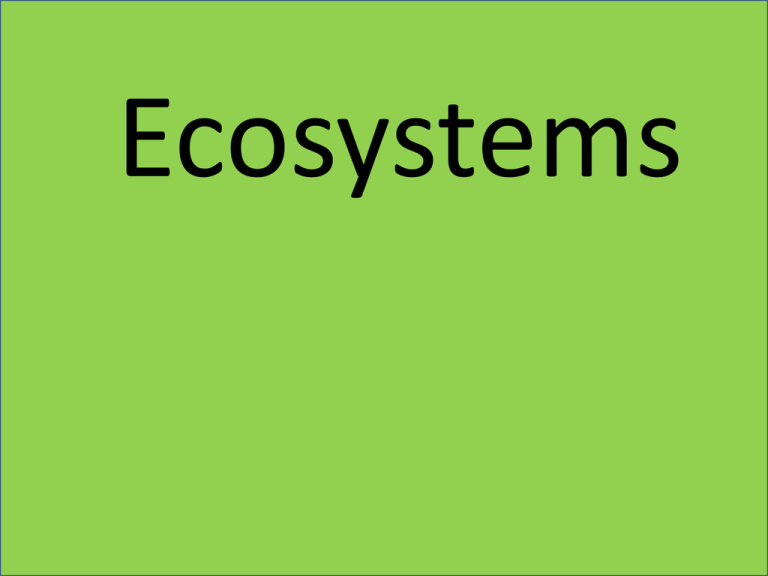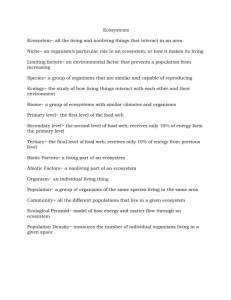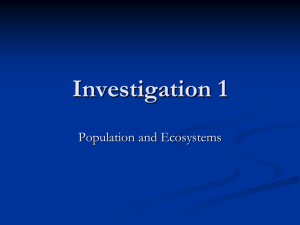Ecosystem - s3.amazonaws.com
advertisement

Ecosystems What makes areas of the world different from each other? Biotic factors– living parts of an ecosystem Abiotic factors– Non living parts of an ecosystem Two types of ecosystems Aquatic – having to do with the water Terrestrial – having to do with land Biome Ecosystem Community population Biome - a group of similar ecosystems that are in the same area. Ecosystem - the organisms in an area, and their habitat. Community – a group of organisms that are living in the same area and interact with each other. Population – a group of the same type of organism. Tundra •Near north and south poles •Little rain fall •Poor soil that is almost always frozen •Grasses, shrubs, moss and lichens grow, few trees •Polar bear, caribou, arctic wolves Deciduous Forest/Temperate Forest •Medium amount of rainfall •Have many different types of trees, deciduous tree leaves change color in fall •Squirrels, deer, foxes, •NC biome Grasslands •Small amount of rainfall • Mostly grass •Large and small herbivores live here Tropical Forest •A lot of rainfall •Warm climate (near equator) •Many species of plants and animals Desert •Very little rain •Can be warm or cold •Some grass, cactus, sage brush – all drought resistant plants Producer First level (primary) consumer Secondary consumer Tertiary consumer Food Chain Top consumer What is a Food Web? Food Chain – the transfer of energy between organisms in an ecosystem Food Web – a diagram that shows the relationships between different food chains in an ecosystem Producer – make and use their own nutrients (plants) Consumer – organisms that must eat other organisms to get energy Decomposer – gets energy by breaking down remains of dead organisms. FBI Not scavengers! Herbivore – An animal that eats only producers (first level consumer) Carnivore – an animal that eats other animals (second level consumer) Omnivore – eats both plants and animals Trophic levels – levels on the energy pyramid that show what level of consumer an animal is on a food chain (primary, secondary, tertiary...top consumer). Top consumer -90 -90 -90 Energy Pyramid A diagram that shows how much food energy is passed from each level in a food chain to the next. Predator – Animal that kills and eats other animals Prey – An animal that is eaten by a predator Aquatic Ecosystems Aquatic ecosystems are categorized based on the amount of salt in the water. (salinity) Estuary – where freshwater meets salt water at the coast Estuary • The saltiness of estuaries fluctuates, but typically there is less salt in an estuary because freshwater flows into the area. Salt Marsh Swamp Estuaries are biologically diverse, containing many unique organisms. The tides circulate nutrients as well as remove waste. The freshwater also carries nutrients to the estuary. Marine Ecosystem (Oceans/seas) Marine ecosystems have a very high salt content. They are warmer and have lots of sunlight near the surface of the water, but get colder and darker the deeper the water gets. An abundance of plants and animals live in the ocean. Marine Ecosystems include…. Beaches Tide Pools Ocean Floor Coral Reefs








